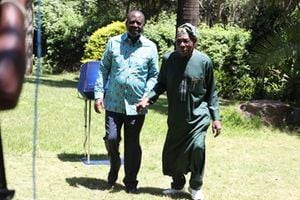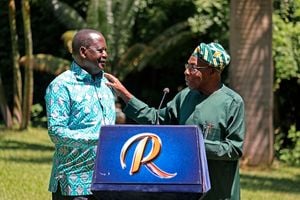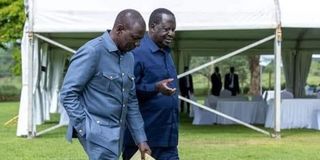
President William Ruto (left) and opposition leader Raila Odinga in Kisozi, Uganda, on February 26, 2024.
The photo dump came late in the evening. It was accompanied by a short, 91-word statement that talked of “the ultimate goal to form the East African Political Federation” and “critical issues that affect our two countries such as energy and petroleum”, but very few people noticed these little gems of diplomatic twaddle. The story was not in the text, but in the photos.
President William Ruto stood in the bushland of Kisozi, Uganda with his host, Yoweri Museveni. And with them was an unlikely candidate, Raila Odinga, perhaps one of the most divisive characters in Kenya Kwanza circles since he ran, unsuccessfully, against Dr Ruto in the last General Election.

President William Ruto (left), opposition leader Raila Odinga and Uganda's President Yoweri Museveni in Kisozi, Uganda, on February 26, 2024.
Since then, Mr Odinga has been a thorn in the flesh of the Ruto administration. He has claimed all manner of things against the President and his government, including the belief that his victory was stolen, that the current administration is illegitimate, that Dr Ruto is mismanaging the country, and that he and his cohorts should be kicked out of office through a series of protests.
So why would this same man, the architect of a series of sentimental and violent protestations against the Kenya Kwanza government, be photographed in the Kisozi plains in the company of his arch-nemesis, herding Museveni’s Ankole cows? Was there a thawing of hostilities between the two, and could this, as many suggested online, be the beginning of a new ‘Handshake’ era? If so, what would it mean to the rank and file of the Kenya Kwanza brigade, most of whom have this passionate, vehement dislike for Mr Odinga?
The first photo in the series showed Mr Odinga standing between Dr Ruto and Mr Museveni, and behind them the long-horned cows grazing in the lush of Kisozi. They all are supporting themselves with herding canes, the type that African herdsboys like to walk around with as a mark of authority and village swagger.
Kaunda suit
Dr Ruto is in what has now become his trademark Kaunda suit while Mr Odinga stands in the middle, his left hand in his pocket and the right holding the cane. Mr Museveni appears to be the one talking in the shot, which captures him gesticulating in an oversize shirt. To the uninitiated eye, this could pass as just another episode of banter among three African statesmen, but to those who have followed Kenya’s robust political scene in the last one year, this photograph spoke volumes about both Mr Odinga and Dr Ruto.
If also offered silent but powerful insights into the psyches of two of Kenya’s most prominent politicians who were once bossom buddies, but who had a dramatic parting of ways slightly more than 10 years ago. That the President, who has borne the brunt of criticism from the Odinga camp, and who has himself castigated the Opposition leader for attempting to overthrow his government, would be meeting with that same man surprised many.
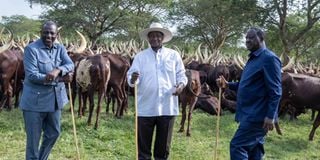
President William Ruto (left), Uganda's President Yoweri Museveni and opposition leader Raila Odinga in Kisozi, Uganda, on February 26, 2024.
Mr Robert Alai, the ODM Member of County Assembly for Kileleshwa Ward in Nairobi, tweeted: “Let me tell you with a lot of certainty; if Baba is not in the race in 2027, and given between (Wiper Democratic Movement leader) Kalonzo (Musyoka) and Ruto, ODM supporters would easily go for Ruto.”
He went on to claim that “ODM supporters would trust Ruto over Kalonzo any day”, and finished the tweet with a tongue-in-cheek warning that also exposed the thinking within the ODM fraternity, that “I know that Rigathi Gachagua and Uhuru hate this more than anyone else, but that's the truth”.
Mr Rigathi Gachagua is Dr Ruto’s deputy, a ruthless political schemer who comes complete with an acerbic tongue and the power to mobilise millions to his fold through grassroots mobilisation. Many see Mr Odinga’s warming-up to Dr Ruto as a repeat of the Uhuru Kenyatta years, when the ODM leader was accused of elbowing out Dr Ruto from the Kenyatta high table. Could this new relationship, therefore, signal the beginning of the end for Mr Gachagua, who has been steadfastly loyal to the President, and who has been keen to establish himself as the Mt Kenya political kingpin? Should that happen, would Mt Kenya, which rebelled against Mr Kenyatta for, among others, abandoning his “brother” William Ruto for the Raila ‘Handshake’, go with the tide and embrace Raila, or agitate in favour of its son, Gachagua?
The President has been keen to introduce his new bonhomie with Mr Odinga as part of a campaign to help the ODM leader ascend to the chairmanship of the African Union in Addis Ababa, Ethiopia. Mr Odinga has himself expressed interest in the position and is banking on Dr Ruto’s ambassadorship to, one, nominate him, and, two, launch and fund a continental campaign blitzkrieg in his favour. The voting for the AU chairmanship is slated for next year, but even before then it is already causing political jitters across the country.
The Kisozi pictures, however, go beyond that African Union dream. They tell the story of brilliant political calculations, patience that defies logic, and the fragile nature of partisan relationships. By accepting Mr Odinga into his fold and even propping him up for the AU chairmanship, Dr Ruto has shifted the tectonic plates of the country’s political landscape in his favour. He has presented himself as a true, forgiving and tolerant statesman who is willing to cross political lines and sheath his bayonet. Most importantly, he has, with little effort, put an end to the seize mentality that governs Kenyan politics, diffusing anger and sectarian tensions and pointing the nation away from the chaos of its virulent dogmaticism.
This is a political masterstroke from Dr Ruto, who is himself known as a hard-nosed, imperturbable strategist. Should Mr Odinga get the AU position, he would be out of circulation during campaigns in 2027, when Dr Ruto hopes to successfully defend his seat. With the Opposition already divided over who should succeed Mr Odinga, and with both Kalonzo and former Kakamega governor Wycliffe Oparanya jostling to take over, Dr Ruto would literally be running against himself in 2027.
Most notably – and perhaps terrifyingly, too – is that, should Mr Odinga fail in his AU bid, he would be ‘damaged goods’; his credentials beaten, his African standing whittled down, and his Opposition clusters in total disarray. In the ensuing commotion, and with his social and political standing in disarray, he would be hamstrung on the campaign trail, giving Dr Ruto a fantastic head start to his own race.
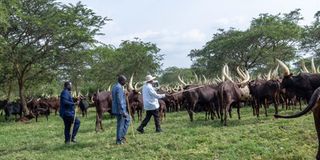
Opposition leader Raila Odinga (left) President William Ruto and Uganda's President Yoweri Museveni in Kisozi, Uganda, on February 26, 2024.
In Kisozi, both Dr Ruto and Mr Odinga fired up our collective imagination. They shocked us, just as they calmed our nerves. So powerful, so important, so shuddering were these photos that they went viral on social media soon after the official X and Facebook accounts of the Presidency shared them. By 3pm on Tuesday, barely 17 hours after they were shared, the three posts on X that highlighted the meeting had accumulated a combined 1.8 million impressions. The aggregated value of those impressions could be in the tens of millions, given that these images gained virality within seconds and were shared more than 20,000 times on Facebook and X alone.
The photos once again captured the power of photography in the right moment. State House did not officially share them with newsrooms, and the meeting had not been announced earlier, as is usually the case. But where they lacked in protocol and stateliness, they made up for it with the setting and the powerful yet muted message they conveyed. In the words of Nation Visual and Syndication Editor Joan Pereruan, both Raila and Ruto were projected in the images as “friends walking down the same path”.
“They are satisfied with the outcome of the meeting,” she says. “There is no tension among them, and both appear casual and relaxed. These are African fathers in both spirit and flesh, coming together in a shared vision, and being happy to share their newfound camaraderie in a casual setting, away from the drabness of State House photo-ops.”
To Ms Pereruan, however, Mr Museveni is the man of the moment. The best photo from the series is that of the three men standing in the wild, with Museveni in the middle. It captures conflict resolution in the African way and style, with an elder statesman guiding two warring sons and bringing them to his familial bonds.
And that, perhaps, is the power of photography in the right moment.

